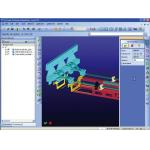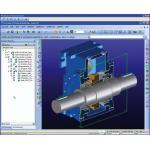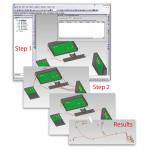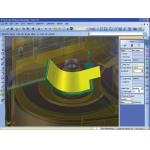Latest News
February 1, 2007
By Mike Hudspeth
We’ve all heard the proverb, “There’s more than one way to skin a cat.” While its origin is debated, the expression’s general meaning holds true for 3D modeling.
In most 3D modelers there are multiple ways to accomplish any job. Each process has its own advantages and disadvantages, and it’s up to the modeler to decide how to accomplish a given task. While it might seem the whole world is jumping on the parametric bandwagon, one company that isn’t is Co Create. It has steadfastly maintained that parameters aren’t the thing. In fact, Co create. will tell you that to them,geometry is king. Nowhere is that more eloquently spelled out than in the latest release of its OneSpace 2007 modeling software.
OneSpace Modeling 2007 is a non-history-based modeling system, which means the order in which you do things doesn’t matter. STEP and IGES data is basically native data to OneSpace Modeling 2007 so you can bring in data from anywhere. This approach safeguards your legacy design data, giving you an extra measure of confidence that you can always work with the data you’ve spent years creating. You can do this because OneSpace 2007 really only concerns itself with the geometry of your model. It doesn’t care if a projection is a boss, a cylinder, etc.It just represents it with high precision. Of course, you can always make changes to that geometry. Co create. likes to call its approach Dynamic Modeling. You can make changes directly to the model with outthinking about the construction infrastructure that created it. OneSpace 2007 consists of several modules: Modeling, Model Manager, FEA analysis, and Surfacing.
OneSpace Modeling Figure 1: Move by Box notifies you about what is going to change. When you window in the geometry, the highlighting is color-coded. Cyan parts will move without changing. Yellow parts will have changes made to their 3D geometry. Blue parts are held by assembly constraints attached to them.
In OneSpace 2007 you have powerful assemblies capabilities, although there is no part or assembly mode, per se. You are always in “product mode.” As such you can always make changes to the parts you have loaded. There is a Structure Tree in the Structure Browser that you can use to keep track of everything: Think of it as your bill of materials.You can turn components on or off there. You can use the “Move by Box"command to capture within a window the objects you want to move and sort of stretch it to where you want it to be. Parts that are completely in the box are moved and parts that aren’t are stretched(see Figure 1, page 30). Everything else remains unchanged. You were able to make changes across multiple assemblies for some time in OneSpace, but 2007 added the move.
OneSpace 2007 also has Clipping Planes. You can create as many as six planes and use them to temporarily cut parts of your model away so you can work on details that might otherwise be obscured. One nice feature of Clipping Planes is that you can exclude parts of an assembly from the clip (see Figure 2, page 31). Say you’re working on a motor: You can exclude the shaft and slice the rest of the model in two. New to this feature in OneSpace 2007 is the ability to do cross-sectional design. That means you can select a cross-sectioned edge and the entire face will be selected. You can make changes to the whole part by moving that edge the same way you might in a 2D program. It saves a lot of rotating and restoring the view to a position normal to the section.
OneSpace Modeling Figure 2: Although the feature is not new to OneSpace 2007, you can slice and dice your models to get at the very heart of your design.Then, when you’re done making changes you can turn the Clipping Planes off and your model comes right back together.
OneSpace 2007 has some new blending capabilities that will make life easier for users. What do you do when you want to place a large blend to a small face? In OneSpace 2007 you can use Face to Edge Blend. Basically, this allows you to pick the face you want the blend to be tangent to and an edge to intersect and OneSpace 2007 will apply the blend, covering up the adjacent face. It doesn’t forget it’s there;think of it as putting the face to sleep. If you need to change the blend later such that the sleeping face returns, it will. (It’s almost like history, but it’s really more of a property that is being stored in the background.)
Most other 3D modelers don’t like getting rid of a face to create a blend. They’d rather crash, instead. They also don’t always like blends that overlap other features like bosses. OneSpace 2007 lets you do just that without any trouble.
Another nice thing about 2007’s blending is that if you need to add draft to something, it doesn’t matter if you’ve blended it or not. Since there’s no history feature, order isn’t a limitation. If you apply draft, OneSpace 2007 knows the blends need to stay tangent to the associated faces. It will update the blends accordingly (see Figure 4,page 33). This is a big improvement over having to monkey around with getting everything the way it should be. And speaking of taper, have you ever had to change tapers on a feature? Do you specify the total angle you want the face to be or just how much more angle you want to add? OneSpace 2007 lets you swing both ways, as it were.
OneSpace Modeling Figure 3: Cabling is very straightforward in OneSpace 2007. You pick where you’re going to end the cables (1), then the path you want the cables to take (2), then Voila! It’s done.
Most products nowadays require some kind of electrical harnessing, and creating models for the harness can be a real headache. Some modelers actually have separate software modules for wiring harnesses. In onEspace 2007 you have that same capability as a built-in function. You start out by identifying where you will end the wires. If you have connectors modeled, the wires will end there. Then you can lay out the general path you want the wires to take to get to the connectors. Finally, you let ‘er rip! OneSpace 2007 will take what you’ve entered and model the wiring for you (see Figure 3, above). It’s really slick.
There’s More
I wish I had enough space to tell you more about Co create. OneSpace2007. It is a great modeling tool. You can generate and maintain just about anything you can imagine, simply and easily.
Figure 4: In history-based systems you usually have to watch what order you put on blend and taper features, otherwise you might wind up with blends that are not tangent to the tapered face. Not so with OneSpace2007. It’ll keep everything as it’s supposed to be.
OneSpace Modeling
The standard edition starts at $6,300, depending on what modules you buy. Model Manager, Co create.‘s PDM solution, and OneSpace.net, its collaboration module, cost $1,000 each. To get a feel for OneSpace Modeling 2007, try out the free Personal Edition (see Free OneSpace Personal Edition, page 32). It offers an unrestricted set of features,but for a 60-part maximum for assemblies. It’s certainly worth the try.
Mike Hudspeth is a senior designer for a global medical company and has been using a wide range of CAD products for 20 years. He, his wife, two daughters, and their cats live outside of St. Louis, MO. Send your comments about this article through e-mail by clicking here. Please reference “OneSpace 2007” in your message.
Free OneSpace Personal Edition
If you’re looking for a way to get into 3D solid modeling but your budget is nonexistent, Co create. is now offering its stand-alone OneSpace Modeling Personal Edition that you can download for free. Itis an easy point of entry into 3D non history-based modeling whether youare a professional designer or a home hobbyist. It gives you a production-ready environment to create whatever you want. You can bring in STEP or IGES data from anywhere. You can design up to 60-partassemblies. The Personal Edition is a separate file format from standard OneSpace. It can be unlocked and converted to the OneSpace file format (free of charge, of course) when you upgrade. This is a limited-time offer (it ends March 31, 2007) so hurry to the CoCreate website for your copy.—M.H.
Info
OneSpace 2007
Co create. Software, Inc.
Fort Collins, CO
Subscribe to our FREE magazine, FREE email newsletters or both!
Latest News










